This post was last updated on July 13th, 2023
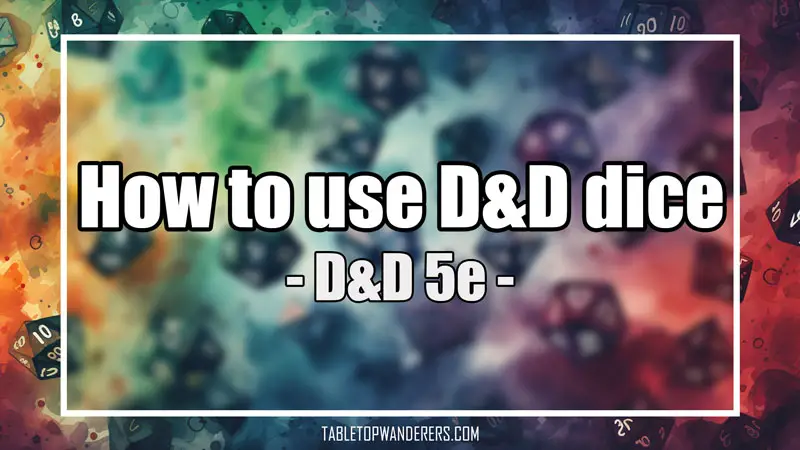
It’s a dark, cold and rainy evening. The light from the fireplace surrounds you in a warm embrace.
The ideal atmosphere for a d&d session.
You’ve invited three friends over to play a D&D one-shot story, and you’re setting up everything you need on the table.
Nothing can ruin the moment when all of a sudden a squeaky voice cuts the atmosphere.
“WhAt tHe HeCk ArE tHeSe WeIrD-sHaPed DiCe?”
“These, my dear friend, are dnd dice!“
“Ah, And HoW do YoU uSe DnD DiCe tHen?”
“It’s very easy. Grab a cup of tea, sit down and relax while I tell you something.”
This could easily be the intro of a very boring story, or perhaps a story based on real events of a long gone past, who knows!
What I actually know, is what you’ll learn from this article if you stick around until the end.
That is: how to use dnd dice, why they have different shapes, what they are used for, and many other interesting facts that no one outside you and your fellow dnd players cares about.
- How to use DnD dice: Understanding Dice Notation
- How to use DnD dice: Different Types of DnD dice
- How to use DnD dice: Dice Usage in Game Mechanics
- How to use DnD dice: Types of Dice Materials
- How to use DnD dice: Digital and Physical Dice
- How to use DnD dice: Chance, Probability, and Randomness
- Frequently Asked Questions
This post may contain affiliate links. If you click through and make a purchase, I will get a commission at no extra cost to you. See our Affiliate Disclosure.
How to use DnD dice: Understanding Dice Notation
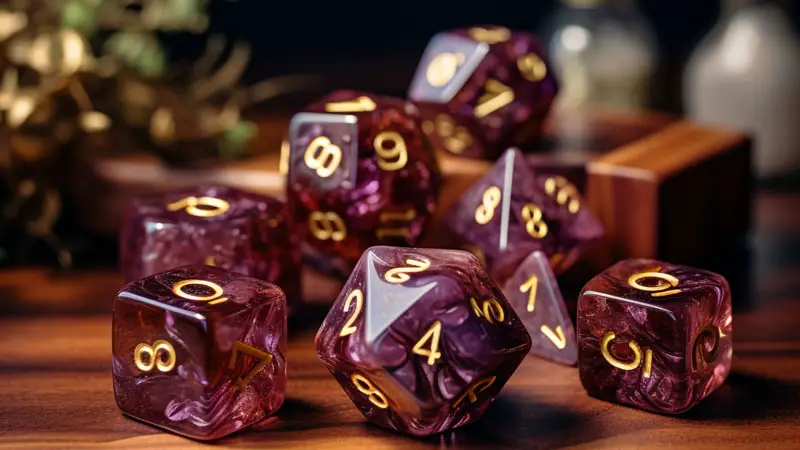
When playing Dungeons & Dragons or other tabletop role-playing games, you’ll often use various types of polyhedral dice to determine outcomes within the game.
Polyhedral dice are shaped like polyhedra, such as tetrahedrons and icosahedrons.
Dice notation is a shorthand way of describing which dice to roll, and how many.
Dice are typically represented by a lowercase ‘d’ followed by the number of sides on the dice.
The most common dice types are d4, d6, d8, d10, d12, and d20.
For example, a d6 is a six-sided die, and a d20 is a twenty-sided die.
You might also encounter percentile rolls, which use two d10 dice to generate a number between 1 and 100. This is often notated as d100 or d%.
To perform a percentile roll, one d10 represents the tens digit and another represents the ones digit.
When rolling multiple dice of the same type, the number of dice rolled is placed before the ‘d’.
For example, if you're instructed to roll 3 six-sided dice, the notation would be 3d6.
In addition to standard dice rolls, some rules might ask you to roll a die and add or subtract a number from the result.
This is indicated by using a plus (+) or minus (-) symbol followed by the number.
For example, if you're rolling a d20 and adding 5 to the result, the notation would be d20+5.
Here’s a brief summary of the dice notation:
- d4 = 4-sided die
- d6 = 6-sided die
- d8 = 8-sided die
- d10 = 10-sided die
- d12 = 12-sided die
- d20 = 20-sided die
- d% or d100 = Percentile roll (two 10-sided dice)
How to use DnD dice: Different Types of DnD dice
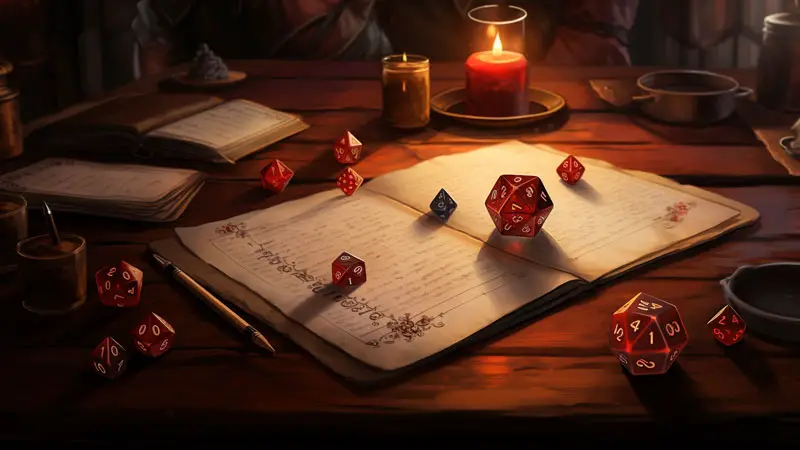
When venturing into the world of Dungeons & Dragons, you’ll quickly encounter the importance of dice; they come in various shapes and sizes.
The d4 is the smallest die in your D&D dice set. It’s a four-sided, triangular pyramid-shaped die known as a tetrahedron.
Players typically use d4s to indicate smaller amounts of damage, like for smaller weapons or low-level spells.
Next up, the classic d6. This cubic die, with six sides, is one you’re probably familiar with from everyday board games.
In D&D, it’s commonly used for weapon damage, ability modifiers, and various types of rolls.
The eight-sided d8 is an octahedron with each face having the shape of a triangle.
It has multiple purposes in the game, such as calculating damage for more potent weapons and some higher-level spells.
A d10 is a bit more unique, being a pentagonal shape with ten sides. It’s used to determine percentages when combined with the percentile dice.
This die is also used for some weapons and spells damage calculations.
Speaking of percentile dice, these are also d10s but have numbers in tens, like 00, 10, 20, and so on up to 90.
You roll a percentile dice along with a regular d10 to determine percentage values, such as rolling a 78 for a percentage-based event.
Taking it up another level, the d12 is a dodecahedron with 12 pentagonal faces. It’s used for various abilities, damage, and other in-game effects that require considerable randomness than the lower dice.
Finally, the king of all dice, the d20. This die is an icosahedron, featuring 20 triangular faces. It’s the backbone of most D&D rolls such as ability checks, attack rolls, and saving throws. The d20 is what makes the game exciting and unpredictable.
As a D&D player, it’s essential to have a well-rounded dice collection, including all the types mentioned above. A standard D&D dice set contains one of each die, making it easier to dive straight into your adventure.
How to use DnD dice: Dice Usage in Game Mechanics
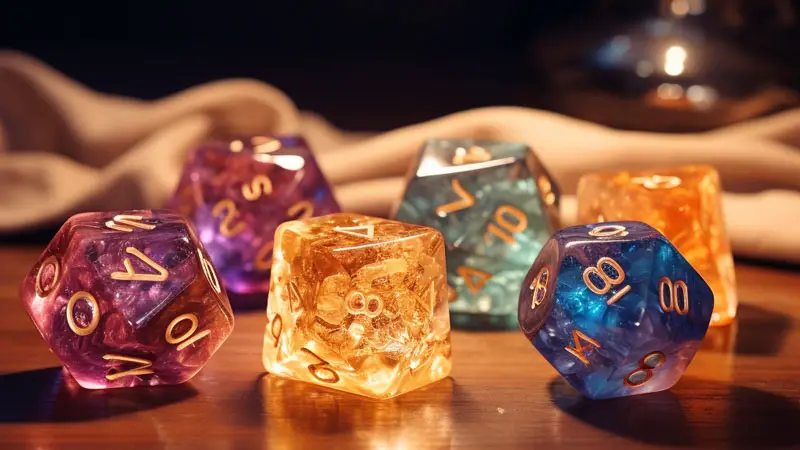
Ability Scores
Your character’s abilities are represented by six scores: Strength, Dexterity, Constitution, Intelligence, Wisdom, and Charisma.
There are different ways to determine these scores and one of these methods is by rolling the dice; basically you roll four six-sided dice (4d6), drop the lowest roll and add the remaining three dice together to get the score for one of the abilities.
Repeat the process until you get the score for all of them.
Attacks and Damage
Attacking in D&D relies on your character’s attack bonus, the weapon or spell being used, and the target’s armour class (AC).
To make an attack, roll a 20-sided die (d20) and add the appropriate attack bonus from your character sheet.
If your result equals or exceeds the target’s AC, you successfully hit and deal damage.
Damage rolls vary based on the weapon or spell being used. For instance, a longsword deals 1d8 damage, while a small weapon like a dagger deals 1d4 damage. Add your character’s relevant ability modifier (Strength for melee attacks or Dexterity for ranged attacks) to the damage roll.
Saving Throws and Skill Checks
In D&D, saving throws represent your character’s ability to avoid or reduce the effects of harmful spells, traps, or other threats. When the DM calls for a saving throw, roll a d20 and add the relevant ability modifier and any other bonuses your character may have (like proficiency or class features).
Skill checks determine how well your character can accomplish specific tasks, like climbing a wall or persuading a guard. When prompted, roll a d20, add the relevant ability modifier, and any proficiency bonus associated with that skill.
Initiative and Initiative Bonuses
Initiative determines the order in which characters act during combat. At the beginning of a battle, roll a d20 and add your character’s Dexterity modifier. The DM will then organise the turn order from highest to lowest initiative rolls. Some classes, like the Rogue or Bard, may grant additional bonuses to initiative.
Hit Points and Hit Dice
Hit points (HP) represent your character’s health. Each class has a specific hit die (e.g. d10 for Fighters or d6 for Wizards) which is rolled at each level-up, and the result is added to your character’s Constitution modifier to determine the increase in HP.
If your HP reaches 0, your character falls unconscious. Healing spells, like a Paladin’s Lay on Hands or a Bard’s Cure Wounds, can restore HP and revive a fallen ally.
Advantage and Disadvantage
Advantage and disadvantage come into play when your character has an upper or lower hand in a situation, as determined by the DM. With advantage, you’ll roll two d20s and take the higher result, while disadvantage means rolling two d20s and taking the lower result.
Critical Hits
When you roll a natural 20 (a 20 on a d20) for an attack, you’ve scored a critical hit.
This means you can roll the damage die twice and add any relevant modifiers, effectively doubling the damage dealt. For example, if you score a critical hit with a longsword, you’d deal “2d8+modifier” rather than “1d8+modifier” damage.
Random Encounters
Random encounters are determined by the DM, often using tables and dice rolls to create unexpected challenges for the party. These can range from monster encounters to finding hidden treasure or meeting an NPC with valuable information.
How to use DnD dice: Types of Dice Materials
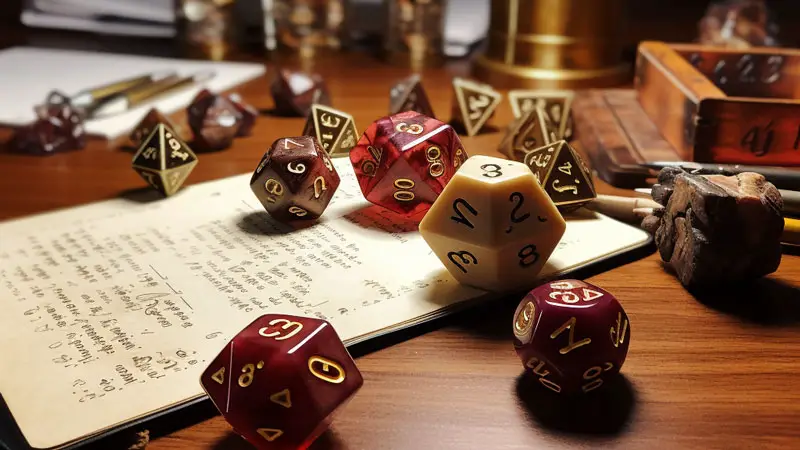
When choosing a dice set for your D&D adventures, you’ll come across a variety of materials and aesthetics.
This section covers the most common types.
Plastic: these dice are the most common type of dice used in tabletop gaming.
They are lightweight, affordable, and come in a wide range of colours and styles.
Plastic dice are easy to produce in large quantities, which makes them a popular choice for game manufacturers.
However, they can be less durable than other materials and may wear down over time with heavy use.
Metal: metal dice are heavier and more durable than plastic ones. They can be made from a variety of metals, including zinc, copper, and aluminium. They often have a premium feel and can be very satisfying to roll; some sets even feature unique finishes like electroplating, giving them a shimmering appearance.
However, they can be more expensive than their plastic counterparts, due to the cost of materials and production, and may damage delicate playing surfaces if not handled with care.
Stone: these are made from materials like marble, jade, and obsidian. They are heavier and more expensive than plastic or metal dice, but they can be very beautiful and unique.
Stone dice often have a natural look and feel, and can be polished or carved to create intricate designs.
On the other hand, they can be more fragile than other materials and may chip or crack if dropped or mishandled.
Wood: wooden dice are lightweight and have a natural look and feel. They can be made from a variety of woods, including maple, oak, and walnut.
Wooden dice can be customized with different stains or finishes to create unique looks, although they can be less durable than other materials and may wear down over time with heavy use.
Resin: resin dice are made by casting liquid resin into moulds. They can be customized with different colors and designs, and often have a translucent or glittery appearance.
Resin dice can be very durable and can withstand heavy use, but they can be more expensive than plastic dice due to the cost of materials and production.
Glass: glass dice are made from tempered glass, which is heated and then rapidly cooled to increase its strength. They are quite fragile and can be easily damaged if dropped, so they aren’t the most practical choice for gameplay (if you want to use them make sure to roll them on a soft surface).
They are often used as decorative pieces due to their unique and beautiful designs.
Crystal: crystal dice are made from natural crystals, such as amethyst, rose quartz, and citrine. They’re often used as decorative pieces rather than for actual gameplay, as they can be quite expensive and fragile. Crystal dice are prized for their natural beauty and unique patterns, and they can be carved or polished to enhance their natural features.
Bone: bone dice are made from animal bones, such as buffalo or cow bones. They have a unique texture and are often carved with intricate designs.
Bone dice are often used in historical reenactments or by people who prefer a more rustic aesthetic. They can be quite durable and are often treated with oils or waxes to protect them from damage.
As you expand your D&D dice set, consider evaluating the balance, legibility, and overall aesthetics of each piece. A well-rounded collection shouldn’t only be visually appealing but also functional, ensuring that you have the perfect dice for every adventure.
How to use DnD dice: Digital and Physical Dice
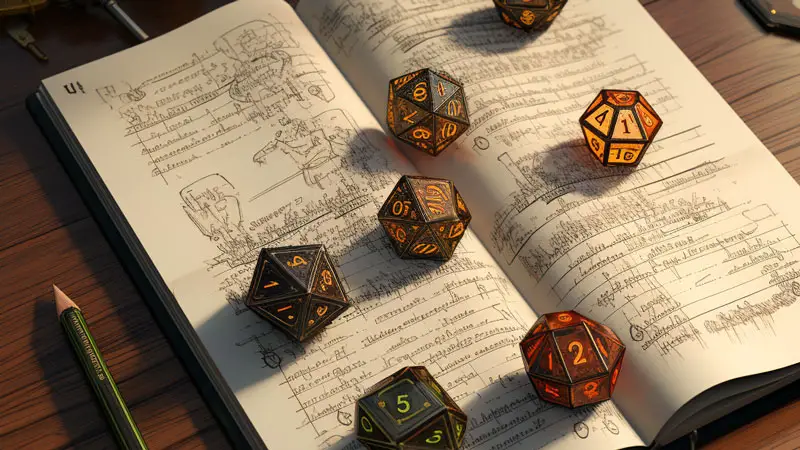
When you play Dungeons & Dragons, you’ll often need to roll dice to determine the outcome of actions and events. There are two primary options for dice rolling: using digital dice or physical dice.
Digital dice can be a convenient option, especially when playing online or when you don’t have a set of physical dice handy.
There are numerous digital dice roller apps available that can easily simulate rolls of different types of dice, ensuring randomness and fairness.
One popular option among D&D players is D&D Beyond, which offers an integrated digital dice roller within its platform.
Using digital dice can also make tracking rolls and results easier, and, in some cases, can speed up gameplay.
On the other hand, some players prefer the tactile experience of physical dice.
Rolling physical dice can add a sense of ritual and suspense to the game, as well as a personal touch, with many players collecting and customising their dice sets to suit their characters.
It’s important to have a fair and unbiased set of dice with accurate weighting for unbiased results.
To decide which option is best for you, consider your playing environment and personal preferences.
If you have access to physical dice and enjoy the sensory experience of rolling them, then using physical dice may be the ideal choice.
However, if you play online or want a quicker and more streamlined experience, digital dice might be the way to go.
In the end, the most important thing is that you have fun and enjoy your D&D sessions, whether you’re rolling digital or physical dice.
I’m #TeamPhysicalDice. Just saying…
How to use DnD dice: Chance, Probability, and Randomness
In the world of D&D, chance, probability, and randomness play a crucial part in the game. They add an element of unpredictability and excitement, with dice rolls determining the outcome of your actions. Let’s dive into how this works.
Dice rolls are important in determining the outcome of various events. A combination of different types of dice, like d4, d6, d8, d10, d12, and d20, are used to generate random numbers. The higher the number on the dice, the better your chances of succeeding in a task or combat scenario.
For instance, when you’re attempting a task, you might roll a d20 to determine your success. The Dungeon Master assigns a target number called the Difficulty Class (DC), and if your roll plus relevant modifiers meet or exceed the DC, your character succeeds at the task.
Percentile dice (d%) are used when you require more granularity in determining outcomes. These dice come in pairs: one numbered 00-90 (in increments of 10), and another numbered 0-9. Rolling them together produces a result from 1 to 100. They are frequently used for specific situations, such as the likelihood of a percentage-based spell affecting your character.
Understanding randomness is key to making informed decisions for your character. It’s essential to remember that every roll is independent of the previous ones, meaning that rolling a d20 has a 5% chance (1 in 20) of landing on any number.
This concept can help you assess the risk and potential reward of actions you take in the game.
Frequently Asked Questions
What are the different types of dice used in D&D?
In D&D, you’ll encounter various types of dice, typically referred to as polyhedral dice. The most common are the D4, D6, D8, D10, D12, and D20, each with a different number of sides.
How do I read and interpret dice rolls in D&D?
To read and interpret dice rolls, you need to understand the notation. For example, 1d6 means you will roll one six-sided die. If a roll requires a modifier, like 1d6+2, you add the modifier to the rolled number. The total represents the outcome of your action in the game.
What is the purpose of a D20 in D&D?
The D20 is the most iconic die in D&D and is central to the game. You’ll use it for ability checks, attack rolls, and saving throws. The D20 helps determine success and failure when attempting various actions, with higher numbers typically leading to better outcomes.
What are the most common dice used in D&D?
The most common dice used in D&D are the D4, D6, D8, D10, D12, and D20. Each die has a different purpose tied to specific actions or abilities. For example, you might use a D6 for weapon damage or a D10 for percentile rolls.
How can I utilise online dice rollers for D&D?
Online dice rollers are a convenient way to roll dice, especially when playing D&D remotely. To use one, find a reputable roller website or app, enter the necessary dice notation (e.g., 1d20), and click the roll button. The software will generate a random number within the designated range, just like a physical die would.
You should now be ready to dive into your D&D campaign and confidently roll the dice to determine your character’s actions and fate.
Best of luck with your adventures!